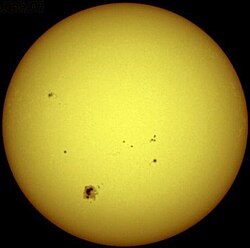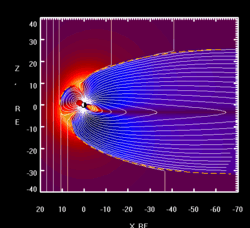Solvind

Solvind er den modulerede, vedvarende udstråling af store mængder partikler fra Solen. Solvinden er solens kosmiske stråling.
Solvind kan muligvis bruges som drivkraft til rumfartøjer ved hjælp af store sejl eller skærme. Accelerationen vil være lille, men den opnåede hastighed kunne blive betydelig selv i astronomiske afstande. Teorien er dog anfægtet og mangler stadig at blive testet i praksis, hvilket dog blev forsøgt i 2005 med opsendelsen af Cosmos 1. Det blev dog rapporteret d. 26. juni 2005 at man ikke kunne få kontakt med sonden efter opsendelsen.
Se også
- solplet, Solstorm, Soludbrud
- polarlys (nordlys, sydlys)
- Jordens atmosfære
- Van Allen-bælterne
Kildehenvisninger
- http://www.sciencenet.dk Arkiveret 11. marts 2007 hos Wayback Machine (Nyheder)
| |||||||||||||||||||||||||||||
Eksterne henvisninger
- Comon.dk, 24. oktober 2003: Geomagnetisk storm kan forstyrre elektronisk kommunikation
- 01. juli 1999, Ing.dk: Beskyttelsen forsvinder når polerne bytter plads
- Anfægtelsen
- 31 October, 2003, BBCNews: Solar storm surge 'not over yet' Citat: "...aircraft traversing the north Atlantic were confined to a narrow corridor to minimise radiation exposure..."
- NASA, ESA: Hot Shots from SOHO: X-whatever Flare! Arkiveret 15. august 2000 hos Wayback Machine, spaceweather.com: Record-setting Solar Flares
- 2003-11-07, ScienceDaily: It's Official: The Biggest Solar X-ray Flare Ever Is Classified As X28 Citat: "...this flare saturated the X-ray detectors on several monitoring satellites..."
- 2003-12-05, Science Daily: Stormy Space Weather Slips Through Cracks Citat: "...The fact that IMAGE was able to view the proton aurora for more than nine hours, until IMAGE progressed in its orbit to where it could not observe the aurora, implies the crack remained continuously open..."
| Spire Denne artikel om astronomi er en spire som bør udbygges. Du er velkommen til at hjælpe Wikipedia ved at udvide den. |
|
Medier brugt på denne side
Simulation of Earth's magnetic field in interaction with (solar) interplanetar magnetic field (IMF): The animation illustrates the dynamical changes of the global magnetic field in the course of a disturbance: a temporary compression of the magnetosphere by enhanced flow of the solar wind is followed by a tailward stretching of the field lines. Eventually, the increase of the tail magnetic field results in a sudden collapse of the nightside field (a substorm ) and a gradual recovery of the magnetosphere to its pre-storm configuration.
The Sun with some sunspots visible. The two small spots in the middle have about the same diameter as our planet Earth.



